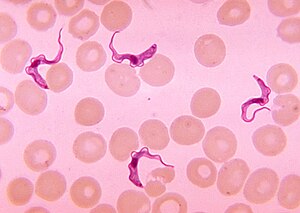African trypanosomiasis, also known as African sleeping sickness or simply sleeping sickness, is an insect-borne parasitic infection of humans and other animals.[3] It is caused by the species Trypanosoma brucei.[3] Humans are infected by two types, Trypanosoma brucei gambiense (TbG) and Trypanosoma brucei rhodesiense (TbR).[3] TbG causes over 98% of reported cases.[1] Both are usually transmitted by the bite of an infected tsetse fly and are most common in rural areas.[3]
Initially, the first stage of the disease is characterized by fevers, headaches, itchiness, and joint pains, beginning one to three weeks after the bite.[1][2] Weeks to months later, the second stage begins with confusion, poor coordination, numbness, and trouble sleeping.[2] Diagnosis is by finding the parasite in a blood smear or in the fluid of a lymph node.[2] A lumbar puncture is often needed to tell the difference between first- and second-stage disease.[2]
Prevention of severe disease involves screening the population at risk with blood tests for TbG.[3]Treatment is easier when the disease is detected early and before neurological symptoms occur.[3]Treatment of the first stage has been with the medications pentamidine or suramin.[3] Treatment of the second stage has involved eflornithine or a combination of nifurtimox and eflornithine for TbG.[2][3]Fexinidazole is a more recent treatment that can be taken by mouth, for either stages of TbG.[3] While melarsoprol works for both types, it is typically only used for TbR, due to serious side effects.[3] Without treatment sleeping sickness typically results in death.[3]
The disease occurs regularly in some regions of sub-Saharan Africa with the population at risk being about 70 million in 36 countries.[5] An estimated 11,000 people are currently infected with 2,800 new infections in 2015.[6][1] In 2018 there were 977 new cases.[3] In 2015 it caused around 3,500 deaths, down from 34,000 in 1990.[4][7] More than 80% of these cases are in the Democratic Republic of the Congo.[1] Three major outbreaks have occurred in recent history: one from 1896 to 1906 primarily in Uganda and the Congo Basin and two in 1920 and 1970 in several African countries.[1] It is classified as a neglected tropical disease.[8] Other animals, such as cows, may carry the disease and become infected in which case it is known as Nagana or animal trypanosomiasis.[1]
| African trypanosomiasis | |
|---|---|
| Other names | Sleeping sickness, African sleeping sickness |
 | |
| Trypanosoma forms in a blood smear | |
| Specialty | Infectious disease |
| Symptoms | Stage 1: Fevers, headaches, itchiness, joint pains[1] Stage 2: Trouble sleeping, confusion, poor coordination[2][1] |
| Usual onset | 1–3 weeks post exposure[2] |
| Types | Trypanosoma brucei gambiense (TbG), Trypanosoma brucei rhodesiense (TbR)[3] |
| Causes | Trypanosoma brucei spread by tsetse flies[3] |
| Diagnostic method | Blood smear, lumbar puncture[2] |
| Medication | Fexinidazole, pentamidine, suramin, eflornithine, nifurtimox[3] |
| Prognosis | Fatal without treatment[3] |
| Frequency | 977 (2018)[3] |
| Deaths | 3,500 (2015)[4] |
The causative agent and vector were identified in 1903 by David Bruce, and the subspecies of the protozoa were differentiated in 1910. Bruce had earlier shown that T. brucei was the cause of a similar disease in horses and cattle that was transmitted by the tse-tse fly (Glossina morsitans).[42]
The first effective treatment, atoxyl, an arsenic-based drug developed by Paul Ehrlich and Kiyoshi Shiga, was introduced in 1910, but blindness was a serious side effect.
Pentamidine, a highly effective drug for the first stage of the disease, has been used since 1937.[48] During the 1950s, it was widely used as a prophylacticagent in western Africa, leading to a sharp decline in infection rates. At the time, eradication of the disease was thought to be at hand.[citation needed][49]
Est. 1800 st.

https://en.wikipedia.org/wiki/African_trypanosomiasis
No comments:
Post a Comment